Included in the Washington Post's list of the 35 most significant women composers in history, identity has always been at the center of composer/pianist Gabriela Lena Frank's music. Born in Berkeley, California, to a mother of mixed Peruvian/Chinese ancestry and a father of Lithuanian/Jewish descent, Frank explores her multicultural heritage most ardently through her compositions. Inspired by the works of Bela Bartók and Alberto Ginastera, Frank is something of a musical anthropologist. She has traveled extensively throughout South America and her pieces often reflect and refract her studies of Latin American folklore, incorporating poetry, mythology, and native musical styles into a Western classical framework that is uniquely her own.
Sueños de Chambi: Snapshots for an Andean Album is inspired by the work of Martín Chambi (1891-1973), the first Amerindian photographer to achieve international acclaim, albeit posthumously. In a career spanning half a century, he recorded as much of Peruvian life, architecture, and landscape as possible, having had the good luck to train with Max T. Vargas in the southern Peruvian town of Arequipa as a young boy. In 1920, he opened a studio in Cuzco, the original capital of the Inca empire, which became the base for his examination of indigenous culture. In his documentation of both the Quechua-speaking descendants of the Incas and the mestizo (mixed-race) elite, Chambi produced more than 18,000 glass negatives depicting the customs and festivals, the working lives and public celebrations of twentieth-century Peruvians.
Chambi was notable for his lack of interest in the industry of touring and exhibiting, buying and selling, and obtaining listings in foreign photography collections and catalogues. As far as he was concerned, his subjects were his constituency. Chambi's desire to integrate his Indian heritage with his artistic talent, his unassuming nature and ease in meeting people regardless of class, caste or race, and his natural curiosity meant that he avoided exoticizing the inhabitants of the high altiplano of Peru. His pictures are consequently direct but not at the expense of pictorial concerns - Throughout his life, Chambi experimented heavily with light sources which can be directly related to his interest in Rembrandt's paintings.
‘Sueños de Chambi ("Dreams of Chambi") is my musical interpretation of seven photos from Chambi's vast collection of pictures. I was first introduced to Chambi's work at the encouragement of compadre and friend Rodney Waters, a fine pianist and photographer himself. Having watched me explore my Peruvian heritage (in music and otherwise) for some time, Rod purchased a slim volume containing some of Chambi's work for me one day... and I fell in love with the images. It was with great difficulty that I picked just seven to muse on in this duo for violin and piano! They are:
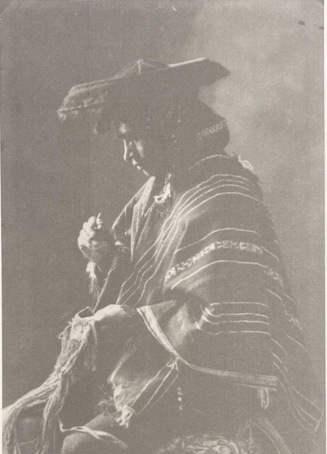 I. Harawi de Quispe: Based on the photo, "Portrait of Miguel Quispe, Cuzco, Peru, c. 1926," this opening movement frames a Cusqueño religious tune (collected by the Peruvian ethnomusicologist Daniel Alomia Robles) in a harawi, a melancholy and emotional song played by a solo quena flute, the quintessential wind instrument of the Andes. Nicknamed "El Inca" for hiking these mountains barefoot, Miguel Quispe was famous for his nonviolent organizations against the deplorable economic conditions of Indians. Here, he is photographed in profile, the lines of his face and Inca outfit quietly brilliant.
I. Harawi de Quispe: Based on the photo, "Portrait of Miguel Quispe, Cuzco, Peru, c. 1926," this opening movement frames a Cusqueño religious tune (collected by the Peruvian ethnomusicologist Daniel Alomia Robles) in a harawi, a melancholy and emotional song played by a solo quena flute, the quintessential wind instrument of the Andes. Nicknamed "El Inca" for hiking these mountains barefoot, Miguel Quispe was famous for his nonviolent organizations against the deplorable economic conditions of Indians. Here, he is photographed in profile, the lines of his face and Inca outfit quietly brilliant.
 II. Diablicos Puneños: This picture ("Danzarin de la Diablada, 1925") features a single dancer dressed as a devil from the southern Peruvian region of Puno. The piano flows attacca into this second movement from the first, setting the scene for a dance number with a singing melody on repeated notes. Black note clusters imitate shacapa percussion (seed rattles strapped to the dancers' thighs) while the violin plays in legato and connected parallel fourths to imitate the tayqa, an extremely large and breathy panpipe.
II. Diablicos Puneños: This picture ("Danzarin de la Diablada, 1925") features a single dancer dressed as a devil from the southern Peruvian region of Puno. The piano flows attacca into this second movement from the first, setting the scene for a dance number with a singing melody on repeated notes. Black note clusters imitate shacapa percussion (seed rattles strapped to the dancers' thighs) while the violin plays in legato and connected parallel fourths to imitate the tayqa, an extremely large and breathy panpipe.
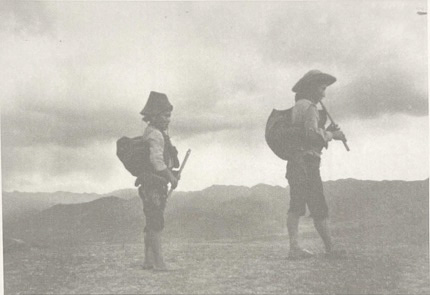 III. Responsorio Lauramarqueño: In this picture ("Shepherds Piping in their Flocks, Lauramarca, Peru, 1929-33"), two shepherds, presumably father and son, are portrayed with their flutes against the backdrop of the Peruvian highlands, calling in their sheep. The music is structured as antiphonal responses between short solo piano interludes and the serrana cantilena melody sung by the violin. The cantilena melody is set against a swinging piano backdrop meant to convey the sound of the wind in the regional trees.
III. Responsorio Lauramarqueño: In this picture ("Shepherds Piping in their Flocks, Lauramarca, Peru, 1929-33"), two shepherds, presumably father and son, are portrayed with their flutes against the backdrop of the Peruvian highlands, calling in their sheep. The music is structured as antiphonal responses between short solo piano interludes and the serrana cantilena melody sung by the violin. The cantilena melody is set against a swinging piano backdrop meant to convey the sound of the wind in the regional trees.
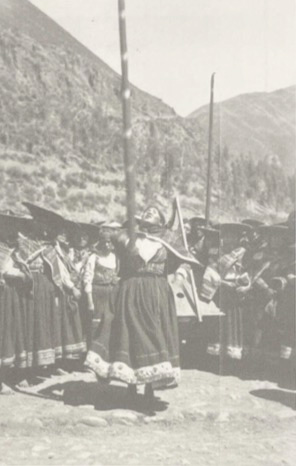 IV. P'asña Marcha: This picture ("The P'asña Marcha, Cuzco, Peru, 1940") features women, known as bastoneras de Quiquijana, who dance for one another. In a game testing their skill, they balance large poles on their hands while performing intricate dance steps. After a capricious opening evoking the tremolo and pizzicato sounds of charangos (instruments similar to the mandolin) and guitars, a karnavalito rhythm persists throughout as an ostinato ground in the piano. The tinya drum is alluded to as well - Small in size, it is one of the only musical instruments commonly played by women in indigenous Peruvian culture.
IV. P'asña Marcha: This picture ("The P'asña Marcha, Cuzco, Peru, 1940") features women, known as bastoneras de Quiquijana, who dance for one another. In a game testing their skill, they balance large poles on their hands while performing intricate dance steps. After a capricious opening evoking the tremolo and pizzicato sounds of charangos (instruments similar to the mandolin) and guitars, a karnavalito rhythm persists throughout as an ostinato ground in the piano. The tinya drum is alluded to as well - Small in size, it is one of the only musical instruments commonly played by women in indigenous Peruvian culture.
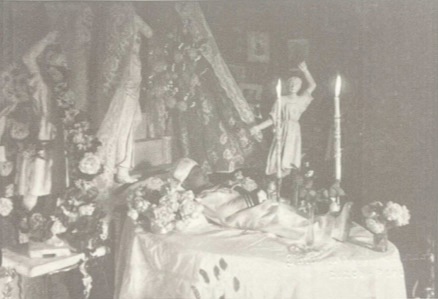 V. Adoración para Angelitos: As a piano solo, this movement sets a Peruvian nursery rhyme (collected by Peruvian ethnomusicologist/composer Andre Sás) to reflect "Dead Child Displayed for the Mourners, Cuzco, Peru, 1920s," a photograph of a deceased child laid out among flowers and candles on a bed, ready for burial.
V. Adoración para Angelitos: As a piano solo, this movement sets a Peruvian nursery rhyme (collected by Peruvian ethnomusicologist/composer Andre Sás) to reflect "Dead Child Displayed for the Mourners, Cuzco, Peru, 1920s," a photograph of a deceased child laid out among flowers and candles on a bed, ready for burial.
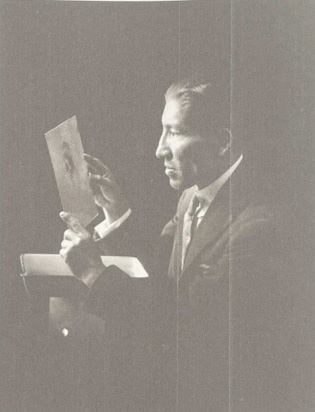 VI. Harawi de Chambi: The sixth photo is a self-portrait of Chambi which caught my eye for its similarity to the first portrait of Miguel Quispe. Both photos are in profile, in tranquil repose of quiet strength, and bathed in a halo of intertwining light and dark. Consequently, the same harawi melody from the introduction is set in the finale. Considering Chambi's penchant for posing in disguise in his pictures in an attempt to get "inside" the setting, I like to think he would have appreciated my linking him to Quispe. I also pay tribute to the folk-influenced music of Bela Bartók by alluding to his second sonata for violin and piano.
VI. Harawi de Chambi: The sixth photo is a self-portrait of Chambi which caught my eye for its similarity to the first portrait of Miguel Quispe. Both photos are in profile, in tranquil repose of quiet strength, and bathed in a halo of intertwining light and dark. Consequently, the same harawi melody from the introduction is set in the finale. Considering Chambi's penchant for posing in disguise in his pictures in an attempt to get "inside" the setting, I like to think he would have appreciated my linking him to Quispe. I also pay tribute to the folk-influenced music of Bela Bartók by alluding to his second sonata for violin and piano.
 VII. Marinera: "Folkloric Musicians, Cuzco, Peru, 1934" is the inspiration for this finale in an enlivened marinera style, a coastal dance popular among folk musicians throughout Peru’.
VII. Marinera: "Folkloric Musicians, Cuzco, Peru, 1934" is the inspiration for this finale in an enlivened marinera style, a coastal dance popular among folk musicians throughout Peru’.